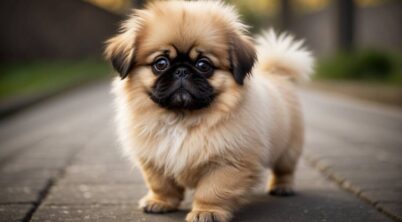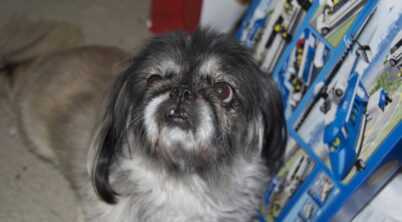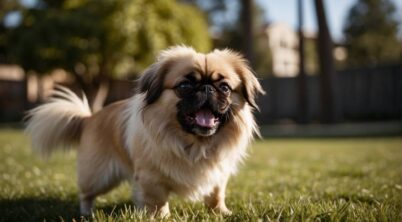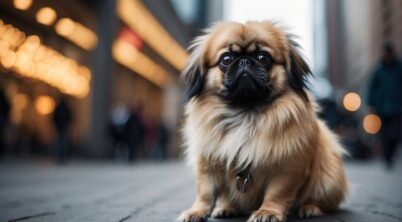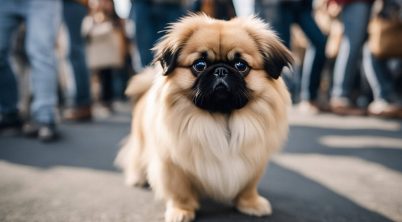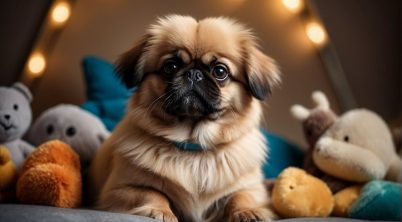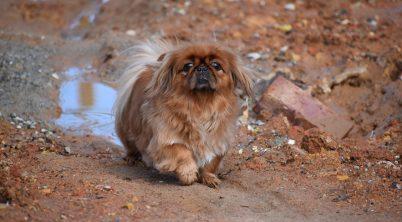The Pekingese, a toy dog breed with ancient Chinese origins, emerged as a revered companion within the Chinese Imperial Court. Their legacy traces back to the city of Beijing, formerly known as Peking, where the Forbidden City—a historical palace complex—stands. These dogs were not merely pets; they were symbols of regality and grace, often associated with Chinese royalty. Their appearance alone, reminiscent of mythical Chinese guardian lions, elevated them to a status that transcended the usual canine roles.
Beyond their ornamental role, Pekingese served a more profound purpose rooted in the spiritual and religious beliefs of ancient China. They were believed to possess magical qualities and played significant roles in religious ceremonies. This deep-seated reverence made them sacred companions, reserved exclusively for the use of the imperial family. The breed’s presence within the palace walls was a testament to its importance and the high esteem in which it was held.
The Pekingese’s outward characteristics—its distinctive lion-like mane, short legs, and pushed-in face—are a result of meticulous breeding to achieve a particular aesthetic aligned with the perceived noble virtues. These traits not only reflect the breed’s historical role as a lapdog of luxury but also its unique status as an emblem of Chinese culture and heritage.
Table of Contents
Pekingese Original Purpose
The Pekingese, a breed originating from China, was revered by Chinese imperial court royalty. The breed’s primary role was that of a companion dog, offering both companionship and status to its owners.
History Highlights
- Sacred Origin: The breed held a sacred role, deeply ingrained in the religious beliefs and practices of ancient China.
- Companionship: They served as lapdogs, providing comfort to members of the royalty.
Characteristics Bred For
- Appearance: Their distinctive flat face, large eyes, and long, luxurious coat were all traits meticulously developed over generations.
- Behavior: Known for their loyalty and affectionate nature towards their owners.
In essence, the Pekingese were much more than pets to the Chinese elite. They were symbols of wealth, luxury, and divine favor. The unique appearance and sociable temperament of the Pekingese were not accidental. They were the result of deliberate and careful breeding practices aimed at creating the perfect imperial companion.
Origins and Historical Significance
The Pekingese breed, traced back to ancient China, holds a sacred place in history, intertwined with Chinese royalty and the divine.
Sacred Symbolism in Ancient China
The Pekingese were more than companion animals; they were revered as sacred symbols within ancient China. According to historical records, these dogs were believed to possess magical powers and played significant roles in religious ceremonies. The breed’s history is deeply rooted in spiritual significance and it is said that they were originally bred for religious purposes by the monks of the Chinese imperial courts.
The Pekingese and Chinese Royalty
Within the Chinese imperial family, the Pekingese were considered a symbol of regal authority and privilege. They were exclusively owned by members of the imperial court, a tradition that highlights the deep bond between the breed and Chinese emperors. The Pekingese’s distinct appearance and proud demeanor resonated with the Imperial China’s aesthetics and values, elevating the breed to a status akin to that of the emperors themselves.
The Breed’s Development and Dissemination
This section tracks the Pekingese’s journey from the lap of Chinese royalty to its embrace by enthusiasts in the West, outlining the evolution of the breed and its establishment abroad.
From Imperial Courts to Western Shores
Once the cherished companions of Chinese imperial rulers, the Pekingese served as symbols of dignity and nobility within the Forbidden City’s walls. Embodied in these canine miniatures were the noble attributes of the lion. The Second Opium War (1856-1860) acted as a pivotal period for the breed’s dissemination when British and French troops invaded the Imperial Summer Palace. Captain John Hart Dunne and other British officers, including Lord John Hay, Sir George Fitzroy, and the Duchess of Wellington, acquired several Pekingese dogs.
One notable Pekingese, named Looty, was presented to Queen Victoria. This gesture marked the beginning of the breed’s introduction to the Western world. Prominent figures such as John Pierpont Morgan and President Theodore Roosevelt played a role in heightening the breed’s allure among Americans.
Recognition and Standards
By the late 19th century, the fascination with the Pekingese had spread throughout Europe and America, leading to the need for formal recognition. The Kennel Club in Britain was among the first to establish a breed standard, defining the desired physical traits that embodied the breed’s dignity and lion-like appearance.
The breed standard emphasized unique features such as their flat faces, a profuse mane, and a rolling gait that mirrored a wobble rather than a walk. Known for their varying coat colors, they were often referred to as “sleeves” due to their history of being carried in the voluminous sleeves of Chinese nobility.
In the early 20th century, the Pekingese continued to grow in popularity, both as a status symbol and as a companion animal. This led to the establishment of specific breeding practices to ensure adherence to the evolving standards. Breed clubs formed in Western nations to maintain these standards, reinforcing the traits that made the Pekingese both distinct and esteemed.
Cultural and Social Impact
The Pekingese dog breed has historically held a significant cultural and social status, serving as a symbol of prestige and influencing art and royalty within Chinese society.
Symbolism and Prestige
In ancient China, the Pekingese, known for its lion-like appearance, was more than just a dog; it was a living symbol of Buddhist mythology and prestige. Connected to the lion, which is an important Buddhist symbol, the Pekingese were revered as divine canine representations, embodying protective qualities and regal bearing. This imperial dog was so esteemed in Chinese culture that it was only owned by Chinese royalty, enhancing the exclusivity and privilege associated with the breed.
- Limited Ownership: Ownership was restricted to the members of the Chinese imperial palace.
- Sleeve Dogs: Some Pekingese were bred to be small enough to fit in the wide sleeves of the royalty, commonly referred to as “sleeve dogs”.
Influence on Art and Royalty
The Pekingese’s beauty and status as a cherished companion of the royalty in China have left an indelible mark on Chinese art. They are often depicted in various art forms, from the beautiful gardens of Beijing to the intricacies of the Old Summer Palace.
- Palace Imagery: Frequent appearances in paintings and sculptures within imperial palaces.
- Regal Associations: Associated with figures like the Dowager Empress Cixi, who favored the breed.
These dogs were not merely pets but integral aspects of the cultural fabric, embodying the essence of Chinese regality and the luxurious lifestyle of the time. The Pekingese stood as a representation of an elite status, often appearing alongside royalty and in contexts that highlighted its exclusivity and connection to ancient traditions.
The Pekingese in Modern Times
The Pekingese, once bred for Chinese nobility, has transitioned into a beloved family pet. Its legacy continues through modern breeding programs that blend past and present.
Current Status and Trends
Popularity: The Pekingese maintains a consistent popularity in today’s pet market. Its distinct appearance and history as a lapdog for aristocratic families have cemented its status as a desirable breed among dog enthusiasts. The breed flourishes in family environments, known for its loyalty and affectionate nature.
- Trends: Current trends show interest in smaller dog breeds, with the Pekingese sharing the spotlight alongside breeds like the Shih Tzu and Pug. These dogs are particularly favored in urban settings due to their size and adaptability to apartment living.
Modern Breeding and the Legacy
Breeding Programs: Selective breeding practices have been refined to ensure the health and well-being of Pekingese dogs. It is vital to prevent health issues related to their unique physical features, such as their flat faces and compact bodies, which can pose challenges.
- The Legacy: Continuing the legacy of selective breeding, modern programs aim to preserve the distinct characteristics that define the Pekingese, such as their lion-like mane, while also promoting genetic diversity. These efforts honor the breed’s ancient roots, tracing back to the Manchu reign, by producing dogs that remain true to the breed’s standard yet are fit for contemporary life.
* Banner photo by Kristin “Shoe” Shoemaker, cropped | Some rights reserved

